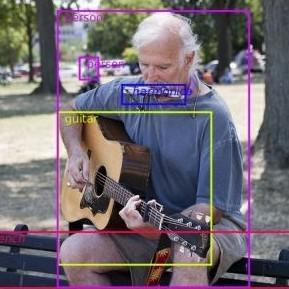Scaling Open-Vocabulary Object Detection
Open-vocabulary object detection has benefited greatly from pretrained vision-language models, but is still limited by the amount of available detection training data. While detection training data can be expanded by using Web image-text pairs as weak supervision, this has not been done at scales comparable to image-level pretraining. Here, we scale up detection data with self-training, which uses an existing detector to generate pseudo-box annotations on image-text pairs. Major challenges in scaling self-training are the choice of label space, pseudo-annotation filtering, and training efficiency. We present the OWLv2 model and OWL-ST self-training recipe, which address these challenges. OWLv2 surpasses the performance of previous state-of-the-art open-vocabulary detectors already at comparable training scales (~10M examples). However, with OWL-ST, we can scale to over 1B examples, yielding further large improvement: With an L/14 architecture, OWL-ST improves AP on LVIS rare classes, for which the model has seen no human box annotations, from 31.2% to 44.6% (43% relative improvement). OWL-ST unlocks Web-scale training for open-world localization, similar to what has been seen for image classification and language modelling.
PDF Abstract NeurIPS 2023 PDF NeurIPS 2023 AbstractCode
Datasets
Results from the Paper
 Ranked #1 on
Zero-Shot Object Detection
on LVIS v1.0 minival
(using extra training data)
Ranked #1 on
Zero-Shot Object Detection
on LVIS v1.0 minival
(using extra training data)
| Task | Dataset | Model | Metric Name | Metric Value | Global Rank | Uses Extra Training Data |
Benchmark |
|---|---|---|---|---|---|---|---|
| Zero-Shot Object Detection | LVIS v1.0 minival | OWLv2 (OWL-ST+FT) | AP | 51.3 | # 1 |









 Visual Genome
Visual Genome
 LVIS
LVIS
 Objects365
Objects365